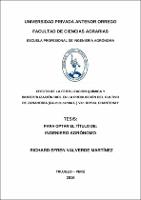Efecto de la fertilización química y biofertilización biol en la producción del cultivo de zanahoria (Daucus carota L.) var. Royal chantenay

View/
Download
(application/pdf: 1.852Mb)
(application/pdf: 1.852Mb)
Date
2017Author(s)
Valverde Martinez, Richard Efren
Metadata
Show full item recordAbstract
El presente trabajo de investigación se desarrolló en la parcela N° 02 del
Señor Eulogio Juárez López ubicado en el sector “La Portada” del Valle
Santa Catalina, distrito de Moche, provincia de Trujillo, región la Libertad.
El objetivo principal de esta investigación fue determinar el efecto de la
fertilización química y Biofertilización BIOL en la producción del cultivo de
zanahoria (Daucus carota L.) Var. Royal Chantenay.
La investigación se dividió en cuatro tratamientos, utilizando fertilizante
químico nitrogenado (urea) y Biofertilización BIOL los cuales fueron los
siguientes: T1 – N (30 kg/ha) + BIOL (1.5 m T3 - BIOL (3 m 3 3 /ha), T2 - N (60 kg/ha), /ha) y T4 – Testigo (Sin aplicación), que se aplicó al suelo.
Los resultados de la investigación nos indican que hubo diferencias
altamente significativas entre tratamientos, resultando el BIOL ser más
eficiente en el rendimiento de raíces de zanahoria a la cosecha logrando
en su tratamiento T3 (BIOL 3m3/ha) 34,557.14 kg/ha a diferencia del
tratamiento T1 que se hace aplicación de mezcla de Biol mas nitrógeno que
logro 30,285.71 kg/ha, el tratamiento T2 con aplicación de fertilizante
químico que logro 27,871.43 kg/ha y el testigo T4 (sin aplicación) que solo
obtuvo 24,285.71 kg/ha, es decir 29.72% menos en relación al T3.
En los parámetros evaluados del diámetro y longitud de la raíz de zanahoria
al momento de la cosecha se obtuvo diferencias altamente significativas
entre tratamientos, resultando el BIOL ser más eficiente logrando en su
tratamiento T3 (BIOL 3m3/ha) con 15.50 cm de diámetro de raíz, tanto que
el testigo T4 (sin aplicación) consiguió solo 11.63 cm, es decir 24.97%
menos en relación al tratamiento T3. En lo que respecta a longitud de raíz
el tratamiento T3 logro 15.71 cm, tanto que el testigo T4 (sin aplicación)
consiguió solo 12.88 cm, es decir 18.01% menos en relación al T3. This research was developed in the plot No. 02 of Mr. Eulogio Lopez Juarez
located in the area “The cover sheet““ del Valle Santa Catalina, Moche
district, Trujillo province, La Libertad region. The main objective of this
research was to determine the effect of chemical fertilization and
Biofertilization BIOL crop production in carrot (Daucus carota L.) Var. Royal
Chantenay.
The research was divided into four treatments, using nitrogen chemical
fertilizer (urea) and Biofertilization BIOL which were: T1 - N (30 kg / ha) +
BIOL (1.5 m3 / ha), T2 - N (60 kg / ha), T3 - BIOL (3 m3 / ha) and T4 - control
(application not), which was applied to the soil. The research results indicate
that there were highly significant differences between treatments, resulting
in the BIOL be more efficient in the performance of carrot roots harvest
achieved in its treatment T3 (BIOL 3m3 / ha) 34,557.14 kg / ha treatment
difference T1 mixing application Biol more nitrogen achievement 30,285.71
kg / ha, treatment T2 with application of chemical fertilizer achievement
27,871.43 kg / ha and T4 control (application not) is only obtained 24285.71
kg / ha, is 29.72% less in relation to T3.
In the parameters evaluated the diameter and length of the carrot root at
harvest time highly significant difference between treatments was obtained,
resulting in the BIOL be more efficiently achieved in its treatment T3 (BIOL
3m3 / ha) to 15.50 cm diameter root, T4 while the control (no application)
only achieved 11.63 cm, that is 24.97% in relation to treatment T3. With
regard to the treatment root length 15.71 cm achievement T3, T4 whereas
the control (application not) only achieved 12.88 cm, which is 18.01% in
relation to T3.
Subject
Collections
- Ingeniería Agrónoma [99]

